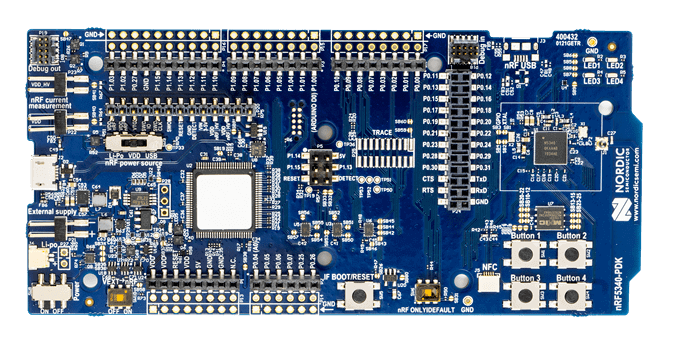nRF5340 PDK¶
Overview¶
The nRF5340 PDK (PCA10095) is a single-board development kit for evaluation and development on the Nordic nRF5340 System-on-Chip (SoC).
The nRF5340 is a dual-core SoC based on the Arm® Cortex®-M33 architecture, with:
a full-featured ARM Cortex-M33F core with DSP instructions, FPU, and ARMv8-M Security Extension, running at up to 128 MHz, referred to as the Application MCU
a secondary ARM Cortex-M33 core, with a reduced feature set, running at a fixed 64 MHz, referred to as the Network MCU.
The nrf5340pdk_nrf5340_cpuapp provides support for the Application MCU on nRF5340 SoC. The nrf5340pdk_nrf5340_cpunet provides support for the Network MCU on nRF5340 SoC.
nRF5340 SoC provides support for the following devices:
ADC
CLOCK
FLASH
GPIO
IDAU
I2C
MPU
NVIC
PWM
RADIO (Bluetooth Low Energy and 802.15.4)
RTC
Segger RTT (RTT Console)
SPI
UARTE
USB
WDT

nRF5340 PDK (Credit: Nordic Semiconductor)¶
More information about the board can be found at the nRF5340 PDK website 2. The Nordic Semiconductor Infocenter 3 contains the processor’s information and the datasheet.
Note
In previous Zephyr releases this board was named nrf5340_dk_nrf5340.
Hardware¶
nRF5340 PDK has two external oscillators. The frequency of the slow clock is 32.768 kHz. The frequency of the main clock is 32 MHz.
Supported Features¶
The nrf5340pdk_nrf5340_cpuapp board configuration supports the following hardware features:
Interface |
Controller |
Driver/Component |
|---|---|---|
ADC |
on-chip |
adc |
CLOCK |
on-chip |
clock_control |
FLASH |
on-chip |
flash |
GPIO |
on-chip |
gpio |
I2C(M) |
on-chip |
i2c |
MPU |
on-chip |
arch/arm |
NVIC |
on-chip |
arch/arm |
PWM |
on-chip |
pwm |
RTC |
on-chip |
system clock |
RTT |
Segger |
console |
SPI(M/S) |
on-chip |
spi |
SPU |
on-chip |
system protection |
UARTE |
on-chip |
serial |
USB |
on-chip |
usb |
WDT |
on-chip |
watchdog |
The nrf5340pdk_nrf5340_cpunet board configuration supports the following hardware features:
Interface |
Controller |
Driver/Component |
|---|---|---|
ADC |
on-chip |
adc |
CLOCK |
on-chip |
clock_control |
FLASH |
on-chip |
flash |
GPIO |
on-chip |
gpio |
I2C(M) |
on-chip |
i2c |
MPU |
on-chip |
arch/arm |
NVIC |
on-chip |
arch/arm |
PWM |
on-chip |
pwm |
RADIO |
on-chip |
Bluetooth, ieee802154 |
RTC |
on-chip |
system clock |
RTT |
Segger |
console |
SPI(M/S) |
on-chip |
spi |
UARTE |
on-chip |
serial |
WDT |
on-chip |
watchdog |
Other hardware features are not supported by the Zephyr kernel. See Nordic Semiconductor Infocenter 3 for a complete list of nRF5340 Development Kit board hardware features.
Connections and IOs¶
LED¶
LED1 (green) = P0.28
LED2 (green) = P0.29
LED3 (green) = P0.30
LED4 (green) = P0.31
Push buttons¶
BUTTON1 = SW1 = P0.23
BUTTON2 = SW2 = P0.24
BUTTON3 = SW3 = P0.8
BUTTON4 = SW4 = P0.9
BOOT = SW5 = boot/reset
Security components¶
Implementation Defined Attribution Unit (IDAU 1) on the Application MCU. The IDAU is implemented with the System Protection Unit and is used to define secure and non-secure memory maps. By default, all of the memory space (Flash, SRAM, and peripheral address space) is defined to be secure accessible only.
Secure boot.
Programming and Debugging¶
nRF5340 Application MCU supports the Armv8m Security Extension. Applications build for the nrf5340pdk_nrf5340_cpuapp board by default boot in the Secure state.
nRF5340 Network MCU does not support the Armv8m Security Extension. nRF5340 IDAU may configure bus accesses by the nRF5340 Network MCU to have Secure attribute set; the latter allows to build and run Secure only applications on the nRF5340 SoC.
Building Secure/Non-Secure Zephyr applications¶
The process requires the following steps:
Build the Secure Zephyr application for the Application MCU using
-DBOARD=nrf5340pdk_nrf5340_cpuappandCONFIG_TRUSTED_EXECUTION_SECURE=yin the application project configuration file.Build the Non-Secure Zephyr application for the Application MCU using
-DBOARD=nrf5340pdk_nrf5340_cpuappns.Merge the two binaries together.
Build the application firmware for the Network MCU using
-DBOARD=nrf5340pdk_nrf5340_cpunet.
When building a Secure/Non-Secure application for the nRF5340 Application MCU, the Secure application will have to set the IDAU (SPU) configuration to allow Non-Secure access to all CPU resources utilized by the Non-Secure application firmware. SPU configuration shall take place before jumping to the Non-Secure application.
Building a Secure only application¶
Build the Zephyr app in the usual way (see Building an Application
and Run an Application), using -DBOARD=nrf5340pdk_nrf5340_cpuapp for
the firmware running on the nRF5340 Application MCU, and using
-DBOARD=nrf5340pdk_nrf5340_cpunet for the firmware running
on the nRF5340 Network MCU.
Flashing¶
Follow the instructions in the Nordic nRF5x Segger J-Link page to install and configure all the necessary software. Further information can be found in Flashing. Then build and flash applications as usual (see Building an Application and Run an Application for more details).
Here is an example for the Hello World application running on the nRF5340 Application MCU.
First, run your favorite terminal program to listen for output.
$ minicom -D <tty_device> -b 115200
Replace <tty_device> with the port where the board nRF5340 PDK
can be found. For example, under Linux, /dev/ttyACM0.
Then build and flash the application in the usual way.
# From the root of the zephyr repository
west build -b nrf5340pdk_nrf5340_cpuapp samples/hello_world
west flash
Debugging¶
Refer to the Nordic nRF5x Segger J-Link page to learn about debugging Nordic boards with a Segger IC.
Testing the LEDs and buttons in the nRF5340 PDK¶
There are 2 samples that allow you to test that the buttons (switches) and LEDs on the board are working properly with Zephyr:
You can build and flash the examples to make sure Zephyr is running correctly on your board. The button and LED definitions can be found in boards/arm/nrf5340pdk_nrf5340/nrf5340_cpuapp_common.dts.